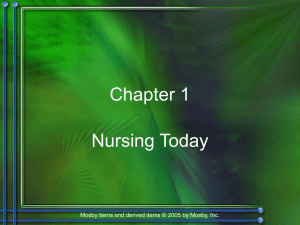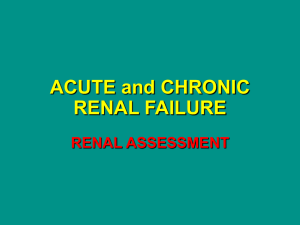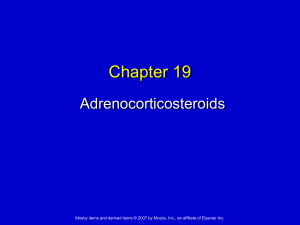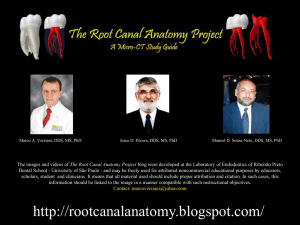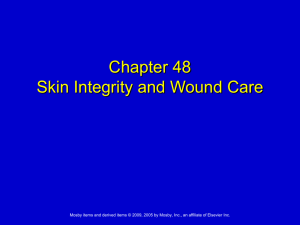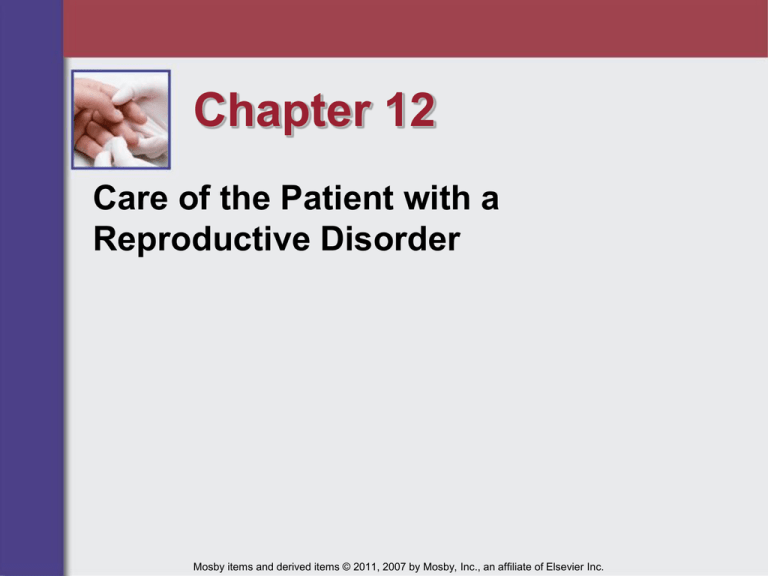
Chapter 12
Care of the Patient with a
Reproductive Disorder
Mosby items and derived items © 2011, 2007 by Mosby, Inc., an affiliate of Elsevier Inc.
Overview of Anatomy and
Physiology
• Male reproductive system
Testes
Ductal system
• Epididymis
• Ductus deferens (vas deferens)
• Ejaculatory duct and urethra
Accessory glands
• Seminal vesicles
• Prostate gland
• Cowper’s glands
Urethra and penis
Sperm
Mosby items and derived items © 2011, 2007 by Mosby, Inc., an affiliate of Elsevier Inc.
Slide 2
Figure 12-1
(From Thibodeau, G.A., Patton, K.T. [2007]. Anatomy and physiology. [6th ed.]. St. Louis: Mosby.)
Longitudinal section of the male pelvis showing the location of the
male reproductive organs.
Mosby items and derived items © 2011, 2007 by Mosby, Inc., an affiliate of Elsevier Inc.
Slide 3
Figure 12-2
(From Thibodeau, G.A., Patton, K.T. [2007]. Anatomy and physiology. [6th ed.]. St. Louis: Mosby.)
Male sex cell (spermatozoon) greatly enlarged (left). Female sex cell
(ovum) surrounded by sperm at time of fertilization (right).
Mosby items and derived items © 2011, 2007 by Mosby, Inc., an affiliate of Elsevier Inc.
Slide 4
Overview of Anatomy and
Physiology
• Female reproductive system
Ovaries
Fallopian tubes
Uterus
Vagina
External genitalia
Accessory glands
• Skene’s glands
• Bartholin’s glands
Perineum
Mammary glands (breasts)
Mosby items and derived items © 2011, 2007 by Mosby, Inc., an affiliate of Elsevier Inc.
Slide 5
Figure 12-3
(From Thibodeau, G.A., Patton, K.T. [2007]. Anatomy and physiology. [6th ed.]. St. Louis: Mosby.)
Longitudinal section of the female pelvis showing the location of the
female reproductive organs.
Mosby items and derived items © 2011, 2007 by Mosby, Inc., an affiliate of Elsevier Inc.
Slide 6
Figure 12-4
(From Thibodeau, G.A., Patton, K.T. [2008]. Structure and function of the body. [13th ed.]. St. Louis: Mosby.)
Sectioned view of the uterus showing relationship to the ovaries and
vagina.
Mosby items and derived items © 2011, 2007 by Mosby, Inc., an affiliate of Elsevier Inc.
Slide 7
Figure 12-6
(From Thibodeau, G.A., Patton, K.T. [2007]. Anatomy and physiology. [6th ed.]. St. Louis: Mosby.)
Lateral view of the breast (sagittal section).
Mosby items and derived items © 2011, 2007 by Mosby, Inc., an affiliate of Elsevier Inc.
Slide 8
Figure 12-7
(From Thibodeau, G.A., Patton, K.T. [2007]. Anatomy and physiology. [6th ed.]. St. Louis: Mosby.)
Mammalian ovary showing successive stages of ovarian (graafian)
follicle and ovum development.
Mosby items and derived items © 2011, 2007 by Mosby, Inc., an affiliate of Elsevier Inc.
Slide 9
Figure 12-14
(From Seidel, H.M., Ball, J.W., Dains, J.E., Benedict, G.W. [2003]. Mosby’s guide to physical
examination. [5th ed.]. St. Louis: Mosby.)
A, Lymph nodes of the axilla. B, Lymphatic drainage of the breast.
Mosby items and derived items © 2011, 2007 by Mosby, Inc., an affiliate of Elsevier Inc.
Slide 10
Human Sexuality
• Sexual identity
The sense of being feminine or masculine
• Influences on sexual health
Overall wellness includes sexual health, and sexuality
should be part of the health care program
• Illness and sexuality
Illness may cause changes in a patient’s self-concept
and result in an inability to function sexually
Mosby items and derived items © 2011, 2007 by Mosby, Inc., an affiliate of Elsevier Inc.
Slide 11
Laboratory and Diagnostic
Examinations
• Diagnostic tests for the female
Colposcopy; culdoscopy; laparoscopy
Papanicolaou (Pap) smear
Biopsies: Breast, cervical, endometrial
Conization; dilation and curettage
Cultures and smears
Schiller’s iodine test
Hysterograms
Mammography; pelvic ultrasonography
Tubal insufflation (Rubin’s test)
Human chorionic gonadotropin; serum CA-125
Mosby items and derived items © 2011, 2007 by Mosby, Inc., an affiliate of Elsevier Inc.
Slide 12
Laboratory and Diagnostic
Examinations
• Diagnostic tests for the male
Testicular biopsy
Semen analysis
Prostatic smears
Cystoscopy
Rectal digital exam
Prostate specific antigen (PSA)
Mosby items and derived items © 2011, 2007 by Mosby, Inc., an affiliate of Elsevier Inc.
Slide 13
The Reproductive Cycle
• Menarche
The beginning of menses
Follows breast development by 2 to 2½ years
Average age range is between 9 and 17 years
Cycle length ranges from 24 to 32 days
The average flow lasts 3 to 5 days
The average flow is 35 mL/cycle
Mosby items and derived items © 2011, 2007 by Mosby, Inc., an affiliate of Elsevier Inc.
Slide 14
The Reproductive Cycle
• Amenorrhea
Etiology/pathophysiology
• Absent or suppressed menstrual flow
Clinical manifestations/assessment
• No menstrual flow for at least 3 months
Medical management/nursing interventions
• Based on underlying cause
• Hormone replacement may be necessary
Mosby items and derived items © 2011, 2007 by Mosby, Inc., an affiliate of Elsevier Inc.
Slide 15
The Reproductive Cycle
• Dysmenorrhea
Etiology/pathophysiology
• Uterine pain with menstruation
Clinical manifestations/assessment
•
•
•
•
•
•
Breast tenderness; headache
Abdominal distention; nausea and vomiting
Vertigo
Palpitations
Excessive perspiration
Colicky, cyclic pain; dull pain in the lower pelvis
Mosby items and derived items © 2011, 2007 by Mosby, Inc., an affiliate of Elsevier Inc.
Slide 16
The Reproductive Cycle
• Dysmenorrhea (continued)
Medical management/nursing interventions
•
•
•
•
•
Exercise
Nutritious foods, high in fiber
Heat to pelvic area
Mild analgesics
Prostaglandin inhibitors
Mosby items and derived items © 2011, 2007 by Mosby, Inc., an affiliate of Elsevier Inc.
Slide 17
The Reproductive Cycle
• Abnormal uterine bleeding
Menorrhagia
• Excessive bleeding during the regular menstrual flow
• Causes: Endocrine disorders; inflammatory
disturbances; uterine tumors
Metrorrhagia
• Uterine bleeding between regular menstrual periods or
after menopause
• May indicate cancer or benign tumors of the uterus
Mosby items and derived items © 2011, 2007 by Mosby, Inc., an affiliate of Elsevier Inc.
Slide 18
The Reproductive Cycle
• Premenstrual syndrome (PMS)
Etiology/pathophysiology
• Believed to be related to the neuroendocrine events
occurring within the anterior pituitary gland
Clinical manifestations/assessment
•
•
•
•
•
•
Irritability, lethargy, and fatigue
Sleep disturbances; depression
Headache; backache; breast tenderness
Vertigo
Abdominal distention
Acne
Mosby items and derived items © 2011, 2007 by Mosby, Inc., an affiliate of Elsevier Inc.
Slide 19
The Reproductive Cycle
• Premenstrual syndrome (PMS) (continued)
Medical management/nursing interventions
• Pharmacological management
Analgesics; diuretics; progesterone
• Dietary recommendations
High in complex carbohydrates
Moderate in protein
Low in refined sugar and sodium
Limit caffeine, chocolate, and alcohol
• Reduce or eliminate smoking
• Exercise; adequate rest, sleep, and relaxation
Mosby items and derived items © 2011, 2007 by Mosby, Inc., an affiliate of Elsevier Inc.
Slide 20
The Reproductive Cycle
• Menopause
Etiology/pathophysiology
• The normal decline of ovarian function resulting from
the aging process
• May be induced by irradiation of the ovaries or surgical
removal of both ovaries
• Not considered complete until 1 year after the last
menstrual period
Mosby items and derived items © 2011, 2007 by Mosby, Inc., an affiliate of Elsevier Inc.
Slide 21
The Reproductive Cycle
• Menopause
Clinical manifestations/assessment
• Decrease in frequency, amount, and duration of the
normal menstrual flow
• Shrinkage of vulval structures; shortening of the vagina
• Dryness of the vaginal wall; pelvic relaxation
• Loss of skin turgor and elasticity
• Increased subcutaneous fat; decreased breast tissue;
thinning of hair
• Osteoporosis
Mosby items and derived items © 2011, 2007 by Mosby, Inc., an affiliate of Elsevier Inc.
Slide 22
The Reproductive Cycle
• Menopause (continued)
Medical management/nursing interventions
• Estrogen therapy
Premarin
Provera
• Calcium supplements
Mosby items and derived items © 2011, 2007 by Mosby, Inc., an affiliate of Elsevier Inc.
Slide 23
The Reproductive Cycle
• Male climacteric
Etiology/pathophysiology
• Gradual decrease of testosterone levels and seminal
fluid production; 55 to 70 years of age
Clinical manifestations/assessment
• Decreased erections; decreased seminal fluid
• Enlarged prostate gland; decreased muscle tone
• Loss or thinning of hair
Medical management/nursing interventions
• Emotional support; treatment for impotence
Mosby items and derived items © 2011, 2007 by Mosby, Inc., an affiliate of Elsevier Inc.
Slide 24
The Reproductive Cycle
• Erectile dysfunction
Etiology/pathophysiology
• Inability of an adult man to achieve penile erection
• Types
Functional
Anatomical
Atonic
Medical management/nursing interventions
•
•
•
•
Remove cause if possible
Treat diseases
Viagra
Mechanical devices: penile prosthesis
Mosby items and derived items © 2011, 2007 by Mosby, Inc., an affiliate of Elsevier Inc.
Slide 25
The Reproductive Cycle
• Infertility
Etiology/pathophysiology
• Inability to conceive after 1 year of sexual intercourse
without birth control
Medical management/nursing interventions
•
•
•
•
•
Depends on the cause
Hormone therapy
Repair occlusion
Intrauterine insemination
In vitro fertilization
Mosby items and derived items © 2011, 2007 by Mosby, Inc., an affiliate of Elsevier Inc.
Slide 26
Infections of the Female
Reproductive Tract
• Simple vaginitis
Etiology/pathophysiology
• Common vaginal infection
• Causative organisms: E. coli; staphylococcal;
streptococcal; T. vaginalis; C. albicans; Gardnerella
Clinical manifestations/assessment
• Inflammation of the vagina
• Yellow, white, or grayish white, curd-like discharge
• Pruritus and vaginal burning
Mosby items and derived items © 2011, 2007 by Mosby, Inc., an affiliate of Elsevier Inc.
Slide 27
Infections of the Female
Reproductive Tract
• Simple vaginitis (continued)
Medical management/nursing interventions
• Douching
• Vaginal suppositories, ointments, and creams
Organism-specific
• Sitz baths
• Abstain from sexual intercourse during treatment
• Treat partner if necessary
Mosby items and derived items © 2011, 2007 by Mosby, Inc., an affiliate of Elsevier Inc.
Slide 28
Infections of the Female
Reproductive Tract
• Cervicitis
Etiology/pathophysiology
• Infection of the cervix
Clinical manifestations/assessment
• Backache
• Whitish exudate
• Menstrual irregularities
Medical management/nursing interventions
• Vaginal suppositories, ointments, and creams;
organism-specific
Mosby items and derived items © 2011, 2007 by Mosby, Inc., an affiliate of Elsevier Inc.
Slide 29
Infections of the Female
Reproductive Tract
• Pelvic inflammatory disease (PID)
Etiology/pathophysiology
• Any acute, subacute, recurrent, or chronic infection of
the cervix, uterus, fallopian tubes, and ovaries that has
extended to the connective tissues
• Most common causative organisms
Gonorrhea; streptococcus; staphylococcus; Chlamydia;
tubercle bacilli
• High risk: Surgical and examination procedures; sexual
intercourse (especially with multiple partners);
pregnancy
Mosby items and derived items © 2011, 2007 by Mosby, Inc., an affiliate of Elsevier Inc.
Slide 30
Infections of the Female
Reproductive Tract
• Pelvic inflammatory disease (PID) (continued)
Clinical manifestations/assessment
•
•
•
•
•
Fever and chills
Severe abdominal pain
Malaise
Nausea and vomiting
Malodorous purulent vaginal exudate
Medical management/nursing interventions
• Antibiotics; analgesics
• Bed rest
Mosby items and derived items © 2011, 2007 by Mosby, Inc., an affiliate of Elsevier Inc.
Slide 31
Infections of the Female
Reproductive Tract
• Toxic shock syndrome
Etiology/pathophysiology
• Acute bacterial infection caused by Staphylococcus
aureus
• Usually occurs in women who are menstruating and
using tampons
Mosby items and derived items © 2011, 2007 by Mosby, Inc., an affiliate of Elsevier Inc.
Slide 32
Infections of the Female
Reproductive Tract
• Toxic shock syndrome (continued)
Clinical manifestations/assessment
• Usually occurs between days 2 and 4 of the menstrual
period
• Flu-like symptoms; sore throat; headache
• Red macular palmar or diffuse rash
• Decreased urinary output; BUN elevated
• Pulmonary edema
Medical management/nursing interventions
• Antibiotics; IV fluid therapy; oxygen
Mosby items and derived items © 2011, 2007 by Mosby, Inc., an affiliate of Elsevier Inc.
Slide 33
Disorders of the Female
Reproductive System
• Endometriosis
Etiology/pathophysiology
• Endometrial tissue appears outside the uterus
• The tissue responds to the normal stimulation of the
ovaries; bleeds each month
Clinical manifestations/assessment
• Lower abdominal and pelvic pain
• May radiate to lower back, legs, and groin
Medical management/nursing interventions
• Antiovulatory medications; pregnancy
• Laparoscopy; total hysterectomy
Mosby items and derived items © 2011, 2007 by Mosby, Inc., an affiliate of Elsevier Inc.
Slide 34
Figure 12-9
Common sites of endometriosis.
Mosby items and derived items © 2011, 2007 by Mosby, Inc., an affiliate of Elsevier Inc.
Slide 35
Disorders of the Female
Reproductive System
• Vaginal fistula
Etiology/pathophysiology
• Abnormal opening between the vagina and another
organ
Clinical manifestations/assessment
• Urine and/or feces being expelled from vagina
Medical management/nursing interventions
• Oral or parenteral antibiotics
• Diet: high protein; increase vitamin C
• Surgery: Repair fistula; urinary or fecal diversion
Mosby items and derived items © 2011, 2007 by Mosby, Inc., an affiliate of Elsevier Inc.
Slide 36
Figure 12-10
(From Herbst, A.L., et al. [1998]. Comprehensive gynecology. [3rd ed.]. St. Louis: Mosby.)
Types of fistulas that may develop in the vagina and uterus.
Mosby items and derived items © 2011, 2007 by Mosby, Inc., an affiliate of Elsevier Inc.
Slide 37
Disorders of the Female
Reproductive System
• Displaced uterus
Etiology/pathophysiology
• Congenital
• Childbirth
• Backward displacement
Retroversion
Retroflexion
Mosby items and derived items © 2011, 2007 by Mosby, Inc., an affiliate of Elsevier Inc.
Slide 38
Disorders of the Female
Reproductive System
• Displaced uterus (continued)
Clinical manifestations/assessment
•
•
•
•
Backache
Muscle strain
Leukorrheal discharge
Heaviness in the pelvic area
Medical management/nursing interventions
• Pessary
• Uterine suspension
Mosby items and derived items © 2011, 2007 by Mosby, Inc., an affiliate of Elsevier Inc.
Slide 39
Disorders of the Female
Reproductive System
• Uterine prolapse
Etiology/pathophysiology
• Prolapse of the uterus through the pelvic floor and
vaginal opening
Clinical manifestations/assessment
•
•
•
•
Fullness in vaginal area
Backache
Bowel or bladder problems
Protrusion of cervix and vaginal walls in perineal area
Mosby items and derived items © 2011, 2007 by Mosby, Inc., an affiliate of Elsevier Inc.
Slide 40
Figure 12-11
(From Seidel, H.M., Ball, J.W., Dains, J.E., Benedict, G.W. [2003]. Mosby’s guide to physical
examination. [5th ed.]. St. Louis: Mosby.)
Uterine prolapse.
Mosby items and derived items © 2011, 2007 by Mosby, Inc., an affiliate of Elsevier Inc.
Slide 41
Disorders of the Female
Reproductive System
• Uterine prolapse (continued)
Medical management/nursing interventions
• Pessary
• Surgery
Vaginal hysterectomy
Anteroposterior colporrhaphy
Mosby items and derived items © 2011, 2007 by Mosby, Inc., an affiliate of Elsevier Inc.
Slide 42
Disorders of the Female
Reproductive System
• Cystocele and rectocele
Etiology/pathophysiology
• Cystocele
Displacement of the bladder into the vagina
• Rectocele
Rectum moves toward posterior vaginal wall
Mosby items and derived items © 2011, 2007 by Mosby, Inc., an affiliate of Elsevier Inc.
Slide 43
Figure 12-12
(From Lewis, S.M., Heitkemper, M.M., Dirksen, S.R. [2007]. Medical-surgical nursing: assessment and
management of clinical problems. [7th ed.]. St. Louis: Mosby.)
A, Cystocele. B, Rectocele.
Mosby items and derived items © 2011, 2007 by Mosby, Inc., an affiliate of Elsevier Inc.
Slide 44
Disorders of the Female
Reproductive System
• Cystocele and rectocele (continued)
Clinical manifestations/assessment
• Cystocele
Urinary urgency, frequency, and incontinence; pelvic
pressure
• Rectocele
Constipation; rectal pressure; hemorrhoids
Medical management/nursing interventions
• Surgical repair
Anteroposterior colporrhaphy; bladder suspension
Mosby items and derived items © 2011, 2007 by Mosby, Inc., an affiliate of Elsevier Inc.
Slide 45
Disorders of the Female
Reproductive System
• Leiomyomas of the uterus (fibroids, myomas)
Etiology/pathophysiology
• Arise from the muscle tissue of the uterus
• Stimulated by ovarian hormones
Clinical manifestations/assessment
• Pelvic pressure; pain; backache
• Dysmenorrhea; menorrhagia
• Constipation; urinary symptoms
Medical management/nursing interventions
• Surgery: Myomectomy; hysterectomy
Mosby items and derived items © 2011, 2007 by Mosby, Inc., an affiliate of Elsevier Inc.
Slide 46
Figure 12-13
(Redrawn from Novak, E. R., Woodruff, J. D., eds. [1967]. Novak’s gynecologic and obstetric pathology.
[6th ed.]. Philadelphia, Saunders. In McCance, K.L., & Huether, S.E. [2002]. Pathophysiology: the
biologic basis for disease in adults and children. [4th ed.]. St. Louis: Mosby.)
Leiomyomas.
Mosby items and derived items © 2011, 2007 by Mosby, Inc., an affiliate of Elsevier Inc.
Slide 47
Disorders of the Female
Reproductive System
• Ovarian cysts
Etiology/pathophysiology
• Benign tumors that arise from dermoid cells of the ovary
Clinical manifestations/assessment
•
•
•
•
May be no symptoms
Palpable on examination
Disturbance of menstruation
Pelvic heaviness; pain
Medical management/nursing interventions
• Ovarian cystectomy
Mosby items and derived items © 2011, 2007 by Mosby, Inc., an affiliate of Elsevier Inc.
Slide 48
Cancer of the Female
Reproductive Tract
• Cancer of the cervix
Etiology/pathophysiology
• Squamous cell carcinoma
• Carcinoma in situ
• If untreated, invades the vagina, pelvic wall, bladder,
rectum, and regional lymph nodes
• High risk
Sexually active during teens
Multiple sexual partners
Multiple births
Chronic cervical infections
Mosby items and derived items © 2011, 2007 by Mosby, Inc., an affiliate of Elsevier Inc.
Slide 49
Cancer of the Female
Reproductive Tract
• Cancer of the cervix (continued)
Clinical manifestations/assessment
•
•
•
•
Few symptoms in early stages
Leukorrhea
Irregular vaginal bleeding; spotting
Advanced
Pain in the back, upper thighs, and legs
Mosby items and derived items © 2011, 2007 by Mosby, Inc., an affiliate of Elsevier Inc.
Slide 50
Cancer of the Female
Reproductive Tract
• Cancer of the cervix (continued)
Medical management/nursing interventions
• Carcinoma in situ
Removal of the affected area
• Early carcinoma
Hysterectomy
Intracavitary radiation
• Advanced carcinoma
Radical hysterectomy with pelvic lymph node dissection
Mosby items and derived items © 2011, 2007 by Mosby, Inc., an affiliate of Elsevier Inc.
Slide 51
Cancer of the Female
Reproductive Tract
• Cancer of the endometrium
Etiology/pathophysiology
• Adenocarcinoma of the uterus
Clinical manifestations/assessment
• Postmenopausal bleeding (50% will have cancer)
• Abdominal pressure; pelvic fullness
Medical management/nursing interventions
• Surgery: total abdominal hysterectomy with bilateral
salpingo-oophorectomy (TAH-BSO)
• Radiation; chemotherapy
Mosby items and derived items © 2011, 2007 by Mosby, Inc., an affiliate of Elsevier Inc.
Slide 52
Cancer of the Female
Reproductive Tract
• Cancer of the ovary
Etiology/pathophysiology
• Fourth most common cause of cancer death in women
• High risk: infertile; anovulatory; nulliparous; habitual
aborters; high-fat diet; exposure to industrial chemicals
Mosby items and derived items © 2011, 2007 by Mosby, Inc., an affiliate of Elsevier Inc.
Slide 53
Cancer of the Female
Reproductive Tract
• Cancer of the ovary (continued)
Clinical manifestations/assessment
• Early
Vague abdominal discomfort
Flatulence; mild gastric disturbance
• Advanced
Enlarged abdominal girth
Flatulence; constipation
Urinary frequency
Nausea and vomiting
Weight loss
Mosby items and derived items © 2011, 2007 by Mosby, Inc., an affiliate of Elsevier Inc.
Slide 54
Cancer of the Female
Reproductive Tract
• Cancer of the ovary (continued)
Medical management/nursing interventions
• Surgery
TAH-BSO and omentectomy
• Radiation and/or chemotherapy
Mosby items and derived items © 2011, 2007 by Mosby, Inc., an affiliate of Elsevier Inc.
Slide 55
Hysterectomy
• Total hysterectomy
Removal of the uterus including the cervix
• TAH-BSO
Removal of the uterus, fallopian tubes, and ovaries
• Radical hysterectomy
TAH-BSO with removal of the pelvic lymph nodes
• Vaginal hysterectomy
The uterus is removed through the vagina
• Abdominal hysterectomy
Abdominal incision is made to perform procedure
Mosby items and derived items © 2011, 2007 by Mosby, Inc., an affiliate of Elsevier Inc.
Slide 56
Disorders of the Female Breast
• Fibrocystic breast condition
Etiology/pathophysiology
• Hyperplasia and cystic formation in mammary ducts
Clinical manifestations/assessment
• Cysts are soft, well-differentiated, tender, and freely
moveable; often bilateral and multiple
Medical management/nursing interventions
• Eliminate methylxanthines
• Danazol (danocrine); vitamin E
Mosby items and derived items © 2011, 2007 by Mosby, Inc., an affiliate of Elsevier Inc.
Slide 57
Disorders of the Female Breast
• Acute mastitis
Etiology/pathophysiology
• Acute bacterial infection of the breast
Clinical manifestations/assessment
• Breasts are tender, inflamed, and engorged
Medical management/nursing interventions
•
•
•
•
Keep breasts clean
Application of warm packs
Support: Well-fitting bra
Systemic antibiotics
Mosby items and derived items © 2011, 2007 by Mosby, Inc., an affiliate of Elsevier Inc.
Slide 58
Disorders of the Female Breast
• Chronic mastitis
Etiology/pathophysiology
• Fibrosis and cysts in the breast
Clinical manifestations/assessment
• Tender, painful, and palpable cysts
• Usually unilateral
Medical management/nursing interventions
• Same as for acute mastitis
Mosby items and derived items © 2011, 2007 by Mosby, Inc., an affiliate of Elsevier Inc.
Slide 59
Disorders of the Female Breast
• Breast cancer
Etiology/pathophysiology
• Unknown cause; usually adenocarcinoma
Clinical manifestations/assessment
• Small, solitary, irregular-shaped, firm, non-tender, and
non-mobile tumor
• Change in skin color
• Puckering or dimpling of tissue
• Nipple discharge; retraction of nipple
• Axillary tenderness
Mosby items and derived items © 2011, 2007 by Mosby, Inc., an affiliate of Elsevier Inc.
Slide 60
Disorders of the Female Breast
• Breast cancer (continued)
Medical management/nursing interventions
• Depends on the stage
Radiation
Chemotherapy
Surgery
o Lumpectomy
o Mastectomy—simple, radical
Mosby items and derived items © 2011, 2007 by Mosby, Inc., an affiliate of Elsevier Inc.
Slide 61
Inflammatory Disorders of the Male
Reproductive System
• Prostatitis
Etiology/pathophysiology
• Acute or chronic infection of the prostate gland
Clinical manifestations/assessment
•
•
•
•
•
•
Chills and fever
Dysuria; urgency and frequency of urination
Cloudy urine
Perineal fullness; lower back pain
Arthralgia; myalgia
Tenderness, edema, and firmness of the prostate
Mosby items and derived items © 2011, 2007 by Mosby, Inc., an affiliate of Elsevier Inc.
Slide 62
Inflammatory Disorders of the Male
Reproductive System
• Prostatitis (continued)
Medical management/nursing interventions
•
•
•
•
Antibiotics
Digital massage of the prostate
Sitz baths
Monitor I&O
Mosby items and derived items © 2011, 2007 by Mosby, Inc., an affiliate of Elsevier Inc.
Slide 63
Inflammatory Disorders of the
Male Reproductive System
• Epididymitis
Etiology/pathophysiology
• Infection of the epididymis
Clinical manifestations/assessment
• Scrotal pain and edema
• Pyuria; chills and fever
Medical management/nursing interventions
• Bed rest
• Elevate scrotum; cold compresses
• Antibiotics
Mosby items and derived items © 2011, 2007 by Mosby, Inc., an affiliate of Elsevier Inc.
Slide 64
Disorders of Male Genital Organs
• Phimosis
Etiology/pathophysiology
• Prepuce is too small to allow retraction of the foreskin
over the glans
• Usually congenital; may be due to inflammation or
disease
Clinical manifestations/assessment
• Infection of foreskin and glans penis
• Occasionally causes obstruction of urine flow
Medical management/nursing interventions
• Circumcision
Mosby items and derived items © 2011, 2007 by Mosby, Inc., an affiliate of Elsevier Inc.
Slide 65
Disorders of the Male Genital
Organs
• Paraphimosis
Etiology and pathophysiology
• An edematous condition of the retracted uncircumcised
foreskin preventing a normal return over the glans
Medical management/nursing interventions
• Warm compresses
• Circumcision
Mosby items and derived items © 2011, 2007 by Mosby, Inc., an affiliate of Elsevier Inc.
Slide 66
Disorders of Male Genital Organs
• Hydrocele
Etiology/pathophysiology
• Accumulation of fluid between the membranes of the
testes
Clinical manifestations/assessment
• Enlargement of the scrotum; pain
Medical management/nursing interventions
• Aspiration of fluid
• Surgical removal of testicular sac
• Bed rest; elevate scrotum; cold compresses
Mosby items and derived items © 2011, 2007 by Mosby, Inc., an affiliate of Elsevier Inc.
Slide 67
Disorders of Male Genital Organs
• Varicocele
Etiology/pathophysiology
• Dilation of scrotal veins causing obstruction and
malfunction of circulation
Clinical manifestations/assessment
• Engorgement and elongation of the scrotum
• Pulling sensation in scrotum; dull, aching pain
Medical management/nursing interventions
• Surgery: Removal of obstruction
• Bed rest
• Elevate scrotum; cold compresses
Mosby items and derived items © 2011, 2007 by Mosby, Inc., an affiliate of Elsevier Inc.
Slide 68
Cancer of the Male Reproductive
Tract
• Cancer of the testis
Etiology/pathophysiology
• Cause unknown
Clinical manifestations/assessment
• Enlarged scrotum; feeling of heaviness
• Firm, painless, smooth mass
Medical management/nursing interventions
• Radical inguinal orchiectomy
• Radiation and/or chemotherapy
• Teach testicular self-examination
Mosby items and derived items © 2011, 2007 by Mosby, Inc., an affiliate of Elsevier Inc.
Slide 69
Cancer of the Male Reproductive
Tract
• Cancer of the penis
Etiology/pathophysiology
• Very rare
Clinical manifestations/assessment
• Painless, wart-like growth or ulceration, usually on the
glans penis
Medical management/nursing interventions
• Surgery
Removal of tissue
Partial or total amputation of the penis
Metastasis: Radical surgical procedures
Mosby items and derived items © 2011, 2007 by Mosby, Inc., an affiliate of Elsevier Inc.
Slide 70
Sexually Transmitted Diseases
• Genital herpes (HSV)
Etiology/pathophysiology
• Infectious viral disease; usually acquired sexually
Clinical manifestations/assessment
•
•
•
•
•
Fluid-filled vesicles
Eventually rupture and develop shallow, painful ulcers
Fever; malaise
Dysuria
Leukorrhea (female)
Mosby items and derived items © 2011, 2007 by Mosby, Inc., an affiliate of Elsevier Inc.
Slide 71
Figure 12-19
(From Beare, P.G., Myers, J.L. [1998]. Adult health nursing. [3rd ed.]. St. Louis: Mosby.)
Herpes simplex virus type II in a male and female patient.
Mosby items and derived items © 2011, 2007 by Mosby, Inc., an affiliate of Elsevier Inc.
Slide 72
Sexually Transmitted Diseases
• Genital herpes (HSV) (continued)
Medical management/nursing interventions
•
•
•
•
•
•
•
•
No cure; treat symptoms
Acyclovir (Zovirax)
Sitz baths
Local anesthetic; analgesics
Keep lesions clean and dry
GOOD handwashing
No sexual contact while lesions are present
Encourage use of condoms
Mosby items and derived items © 2011, 2007 by Mosby, Inc., an affiliate of Elsevier Inc.
Slide 73
Sexually Transmitted Diseases
• Syphilis
Etiology/pathophysiology
• Treponema pallidum organism
• Transmission occurs primarily with sexual contact
Clinical manifestations/assessment
• Incubation period
No symptoms
• Primary stage
Chancre; headaches; enlarged lymph nodes
Mosby items and derived items © 2011, 2007 by Mosby, Inc., an affiliate of Elsevier Inc.
Slide 74
Sexually Transmitted Diseases
• Syphilis (continued)
Clinical manifestations/assessment
• Secondary stage
Rash on palms of hands and soles of feet
Generalized enlargement of lymph nodes
• Latent stage
No symptoms
• Tertiary or late stage
Lesions may affect many different systems; may be fatal
Mosby items and derived items © 2011, 2007 by Mosby, Inc., an affiliate of Elsevier Inc.
Slide 75
Sexually Transmitted Diseases
• Syphilis (continued)
Medical management/nursing interventions
• Pharmacological management
Penicillin
Tetracycline or erythromycin, if allergic to penicillin
• May be treated in any stage; damage from previous
stages will not be reversed
• Treat all sexual contacts
Mosby items and derived items © 2011, 2007 by Mosby, Inc., an affiliate of Elsevier Inc.
Slide 76
Sexually Transmitted Diseases
• Gonorrhea
Etiology/pathophysiology
• N. gonorrhoeae
• Transmitted by sexual contact
Clinical manifestations/assessment
• Vaginal (female)
Urinary frequency and pain
Yellowish discharge
Nausea and vomiting
Mosby items and derived items © 2011, 2007 by Mosby, Inc., an affiliate of Elsevier Inc.
Slide 77
Sexually Transmitted Diseases
• Gonorrhea (continued)
Clinical manifestations/assessment (continued)
• Urethra (male)
Urethral discomfort; dysuria
Yellowish discharge containing pus
Red and swollen meatus
• Rectal (male and female)
Perineal discomfort; purulent rectal discharge
• Pharyngitis (male and female)
Sore throat and swallowing discomfort
Edema of the throat
Mosby items and derived items © 2011, 2007 by Mosby, Inc., an affiliate of Elsevier Inc.
Slide 78
Sexually Transmitted Diseases
• Gonorrhea (continued)
Medical management/nursing interventions
• Pharmacological management
Penicillin
Rocephin
Doxycycline or tetracycline
• Patient education
• TREAT ALL SEXUAL CONTACTS
Mosby items and derived items © 2011, 2007 by Mosby, Inc., an affiliate of Elsevier Inc.
Slide 79
Sexually Transmitted Diseases
• Trichomoniasis
Etiology/pathophysiology
• T. vaginalis protozoan
• Usually sexually transmitted
Clinical manifestations/assessment
• Most are asymptomatic
• Male: Urethritis, dysuria, urinary frequency, pruritus,
and purulent exudate
Mosby items and derived items © 2011, 2007 by Mosby, Inc., an affiliate of Elsevier Inc.
Slide 80
Sexually Transmitted Diseases
• Trichomoniasis (continued)
Clinical manifestations/assessment (continued)
• Female
Frothy, gray, green, or yellow malodorous discharge
Pruritus
Edema
Tenderness of vagina
Dysuria and urinary frequency
Spotting; menorrhagia; dysmenorrhea
Mosby items and derived items © 2011, 2007 by Mosby, Inc., an affiliate of Elsevier Inc.
Slide 81
Sexually Transmitted Diseases
• Trichomoniasis (continued)
Medical management/nursing interventions
• Pharmacological management
Metronidazole (Flagyl)
• Patient education
• TREAT ALL SEXUAL CONTACTS
Mosby items and derived items © 2011, 2007 by Mosby, Inc., an affiliate of Elsevier Inc.
Slide 82
Sexually Transmitted Diseases
• Candidiasis
Etiology/pathophysiology
• C. albicans and C. tropicalis
Clinical manifestations/assessment
• Mouth: Edema; white patches
• Nails: Edematous, darkened, erythematous nail base;
purulent exudate
• Vaginal: Cheesy, tenacious white discharge; pruritus;
inflammation of the vagina
• Penis: Purulent exudate
• Systemic: Chills; fever; general malaise
Mosby items and derived items © 2011, 2007 by Mosby, Inc., an affiliate of Elsevier Inc.
Slide 83
Sexually Transmitted Diseases
• Candidiasis (continued)
Medical management/nursing interventions
• Pharmacological management
Nystatin (Mycostatin)
Topical amphotericin B
• Treat underlying condition
Mosby items and derived items © 2011, 2007 by Mosby, Inc., an affiliate of Elsevier Inc.
Slide 84
Sexually Transmitted Diseases
• Chlamydia
Etiology/pathophysiology
• Chlamydia trachomatis
Clinical manifestations/assessment
• Usually asymptomatic
• Male
Scanty white or clear exudate
Burning or pruritus
Urinary frequency; mild dysuria
Mosby items and derived items © 2011, 2007 by Mosby, Inc., an affiliate of Elsevier Inc.
Slide 85
Sexually Transmitted Diseases
• Chlamydia (continued)
Clinical manifestations/assessment
• Female
Vaginal pruritus or burning
Dull pelvic pain
Low-grade fever
Vaginal discharge; irregular bleeding
Medical management/nursing interventions
• Pharmacological management
Tetracycline; doxycycline; Zithromax
• TREAT ALL SEXUAL CONTACTS
Mosby items and derived items © 2011, 2007 by Mosby, Inc., an affiliate of Elsevier Inc.
Slide 86
Nursing Process
• Nursing diagnoses
Anxiety
Body image, disturbed
Coping, ineffective
Fear
Fluid volume, deficient
Health maintenance,
ineffective
Infection, risk for
Knowledge, deficient
Pain, acute and
chronic
Self-esteem,
situational low
Sexual dysfunction
Skin integrity, impaired
Tissue perfusion,
ineffective
Urinary elimination,
impaired
Mosby items and derived items © 2011, 2007 by Mosby, Inc., an affiliate of Elsevier Inc.
Slide 87
Sex Hormones
Production influenced by the anterior pituitary
Male: testosterone; androgens
Female: estrogen; progesterone
Copyright © 2013, 2010, 2006, 2003, 2000, 1995, 1991 by Mosby, an imprint of Elsevier Inc.
88
Androgens
Actions
Development of secondary sex characteristics; tissue
building
Uses
Hypogonadism, hypopituitarism, dwarfism, eunuchism,
cryptorchidism, oligospermia, and male androgen
deficiency
Adverse Reactions
Edema due to sodium retention, acne, hirsutism, male
pattern baldness, cholestatic hepatitis with jaundice,
buccal irritation, nausea and vomiting, diarrhea
Copyright © 2013, 2010, 2006, 2003, 2000, 1995, 1991 by Mosby, an imprint of Elsevier Inc.
89
Androgens (cont.)
Drug Interactions
Increased effects – anticoagulants, antidiabetic agents,
and other drugs
Decreased effects – barbiturates
Concurrent use with corticosteroids increase edema
Nursing Implications
Assessment, diagnosis, planning, implementation, and
evaluation
Drug Table 21-9
Copyright © 2013, 2010, 2006, 2003, 2000, 1995, 1991 by Mosby, an imprint of Elsevier Inc.
90
Androgens (cont.)
Patient and Family Teaching
Administration
Response time
Diet
Symptoms to report
Administration considerations
Copyright © 2013, 2010, 2006, 2003, 2000, 1995, 1991 by Mosby, an imprint of Elsevier Inc.
91
Female Sex Hormones
Estrogens
Progestins
Table 21-10
Copyright © 2013, 2010, 2006, 2003, 2000, 1995, 1991 by Mosby, an imprint of Elsevier Inc.
92
Estrogens
Action and Uses
Used for hormone replacement therapy in menopause
and other conditions (ovarian failure); infertility workups; palliative breast cancer treatment
Adverse Reactions
Drug Interactions
Copyright © 2013, 2010, 2006, 2003, 2000, 1995, 1991 by Mosby, an imprint of Elsevier Inc.
93
Progestins
Action
Uses
Contraception, control excessive uterine bleeding,
treatment of secondary amenorrhea, dysmenorrhea,
premenstrual tension, and control of pain in
endometriosis
Drug Interactions
Nursing Implications and Patient Teaching
Copyright © 2013, 2010, 2006, 2003, 2000, 1995, 1991 by Mosby, an imprint of Elsevier Inc.
94
Oral Contraceptives
Combination Drugs: Estrogen and Progestin
Table 21-11
Action
Prevent ovulation
Use
Contraception
Adverse Reactions
Estrogen excess, progestin excess, androgen excess,
estrogen deficiency, progestin deficiency
Contraindications for Oral Contraceptives
Copyright © 2013, 2010, 2006, 2003, 2000, 1995, 1991 by Mosby, an imprint of Elsevier Inc.
95

